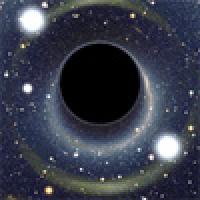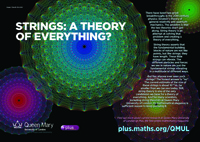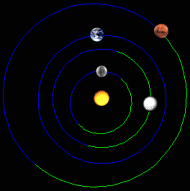
Researching the unknown

Science is much stranger than fiction. It suggests that our Universe may just be one of infinitely many which constantly pop in and out of existence like bubbles in a bubble bath. There may be many more dimensions than the three we can see, rolled up so tightly we can't perceive them. And our Universe is riddled with black holes at whose centres time and space tear themselves apart.
Intrigued? This ongoing project will bring you the latest research on the forefront of physics with the help of researchers from Queen Mary University of London. You don't need to be an expert — our articles, videos and podcasts are accessible, intelligent, informative and fun. And apart from finding out about the science you will hear from the researchers themselves, giving you a glimpse of what it's like to work at the frontiers of physics.
Videos
A geometry for strings — If, as string theory suggests, the world is made of strings, then what does that mean for the geometry we are used to, in which space is made of points? Theoretical physicist David Berman explains in this video.
The physics of language — Sanjaye Ramgoolam uses techniques from physics in linguistics, the study of languages. Find out more about the surprising connection between physics, maths and language in this video.

The mother of all theories — M-theory is currently the strongest contender for a theory of everything. In this video Costis Papageorgakis tells us more about this "mother theory".
Seeing double — Modern physics has a problem: the theory that describes the world at very small scales, quantum physics, and the theory that describes it at large scales, general relativity, don't fit together. Nadia Bahjat-Abbas works on the double copy, a programme to find mathematical similarities between the two conflicting theories. In this video she tells us more.
Black holes and spacetime bubbles — Masaki Shigemori works on one of most fascinating objects in physics: black holes. In this video he tells us how we can detect black holes, what kind of questions he is investigating, and spacetime bubbles.
Articles
From dust to us — Where planets are born is not necessarily where they will stay. Richard Nelson explains planetary migration.
In a lower dimension — Could the world be simpler than our senses suggest? Sanjaye Ramgoolam of QMUL is investigating the possibility.
From dancing alone, to dancing together — We reveal the hidden flexibility within many common materials, and how the way they move can explain many of their properties.
Life after the Higgs boson — We might have found the Higgs boson, but the search for new physics at the LHC isn't over yet.
What is cosmology? — How big is the Universe? Where did it come from and where is it going? Why is it the way it is? These are just some of the questions cosmologists study.
Mysterious neutrinos — Research looks into the bizarre world of neutrinos helps to piece together the creation story of the Universe.
Infinity or -1/12? — A strange "result" has been making the rounds lately. It says that when you add up all the natural numbers 1+2+3+4+... the result is -1/12. Queen Mary physicist David Berman helps us explain why the result is wrong and explores its fascinating roots in physics.
Picture perfect — In 2004 three physicists decided to dabble in a field they knew little about. Within weeks they had developed a new way of drawing pictures that transforms weeks' worth of computer calculations into something that could be done on a single page in an hour. It's used in particle accelerators such as the LHC at CERN.
Physical finance — The fact that a sizeable proportion of the financial workforce is made up of physicists is one of the industry's best-kept secrets. We talk to Laura Tadrowski who has made the leap from physics to finance.
String theory: From Newton to Einstein and beyond — Over the last few years the words string theory have nudged their way into public consciousness. It's a theory of everything in which everything's made of strings; or something like that. But why strings? What do they do? Where did the idea come from and why do we need such a theory? Here is an equation-free introduction for beginners.
The physics of elementary particles — It is extraordinary to think that the diversity of the world we live in is based on a handful of elementary particles and a few fundamental forces. This article describes the combination of experimental and theoretical physics that has brought us to the understanding of today.
Kaluza, Klein and their story of a fifth dimension — Space is three-dimensional... or is it? In fact, we are all used to living in a curved, multidimensional Universe. And a mathematical argument might just explain how those higher dimensions are hidden from view.
The ten dimensions of string theory — String theory has one very unique consequence that no other theory of physics before has had: it predicts the number of dimensions of space-time. But where are these other dimensions hiding and will we ever observe them?
Meet the mother theory — The holy grail for 21st century physics is to produce a unified theory of everything that can describe the world at every level, from the tiniest particles to the largest galaxies. Currently the strongest contender for such a theory is something called M-theory. So what is this supposed mother of all theories all about?
Quantum geometry — One of the many strange ideas from quantum mechanics is that space isn't continuous but consists of tiny chunks. Ordinary geometry is useless when it comes to dealing with such a space, but algebra makes it possible to come up with a model of spacetime that might do the trick.
Activities
Maths meets particle physics — Chrystal symmetries, the Ultra particle, striking gold… Try your hand at these problems from our sister site NRICH related to the physics of fundamental particles.

Explore mathematical physics — Escape from planet Earth, Pack man, Earth Orbit… Try your hand at these problems from our sister site NRICH related to mathematical physics.